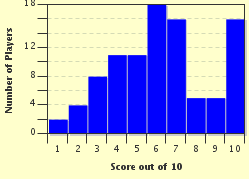Quiz Answer Key and Fun Facts
1. Which natural fiber was often used to make the shrouds of Egyptian Pharaohs?
2. Of all the cellulose fibers, which is said to have the most absorbency?
3. Which fabric usually made from wool, a blend of wool and cotton, or a blend of wool and a synthetic fiber, makes my pajamas and sheets warm and cozy?
4. Which company in the United States was the first to produce polyester fiber?
5. Approximately, how many different breeds of sheep are there for wool production?
6. Classifying fabrics is based on the origin of the fibers which can be natural or synthetic. Which of the following is NOT a natural fiber?
7. Which lightweight fabric is often used in the making of scarves, wedding and evening gowns?
8. What is the name of the twilled wool fabric used extensively in the making of military uniforms, and at one time was considered a fabric of the upper classes?
9. In its purest form, what is the most expensive natural fiber in the world?
10. Which strong fabric can withstand water better than many other textile products?
Source: Author
Irishrosy
This quiz was reviewed by FunTrivia editor
kyleisalive before going online.
Any errors found in FunTrivia content are routinely corrected through our feedback system.


